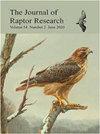1972-2017 年佛罗里达州白头鹰(Haliaeetus leucocephalus)的繁殖数量和人口趋势
IF 1.2
4区 生物学
Q2 ORNITHOLOGY
引用次数: 0
摘要
摘要白头鹰(Haliaeetus leucocephalus)在整个范围内的恢复是北美自然保护的重大成就之一,佛罗里达州的白头鹰种群为这一恢复做出了重大贡献。佛罗里达州是美国48个州中白头鹰筑巢最密集的地区之一,并持续开展了45年的种群监测项目。我们利用1972-2017年的筑巢监测数据来量化佛罗里达州白头鹰繁殖种群的规模、范围和生产力的变化。我们记录了被占领的白头鹰领地数量从 1973 年的 88 个增加到 2017 年的约 1565 个,在监测工作结束时,佛罗里达州 67 个县中有 64 个县记录到了白头鹰的巢。佛罗里达州被占领的白头鹰领地数量的年平均增长率为 5.5 ± 1.1%(SE)。高繁殖率体现在每个被占领巢的平均生产率为 1.13 ± 0.02 只雏鹰,每个成功巢的平均育雏规模为 1.54 ± 0.01 只雏鹰,45 年间共生产了近 40,000 只雏鹰,为该州和美国东南部的白头鹰种群带来了可观的收益。白头鹰已在佛罗里达州建立了一个规模庞大、空间广阔且高产的繁殖种群,其数量超过了2008年该物种被列入国家名录时所设定的保护目标。这些数据为了解佛罗里达州白头鹰的繁殖生态、恢复和长期稳定性提供了重要依据。鉴于预计未来几年人类数量的增加和地貌的改变,保护佛罗里达州的白头鹰种群需要采取适应性管理策略。本文章由计算机程序翻译,如有差异,请以英文原文为准。
Breeding Bald Eagle (Haliaeetus leucocephalus) Population and Demographic Trends in Florida, 1972–2017
ABSTRACT. The range-wide recovery of Bald Eagles (Haliaeetus leucocephalus) is one of the great North American conservation successes, with the Bald Eagle population in Florida contributing substantially to this recovery. Florida has one of the densest concentrations of nesting Bald Eagles in the lower 48 states and sustained a population monitoring program that spanned 45 yr. We used nest monitoring data from 1972–2017 to quantify changes in the size, extent, and productivity of the breeding Bald Eagle population in Florida. We documented an increase in the number of occupied Bald Eagle territories from 88 in 1973 to an estimated 1565 in 2017, with nests recorded in 64 of Florida's 67 counties by the end of the monitoring efforts. Mean annual growth rate in the number of occupied eagle territories in Florida was 5.5 ± 1.1% (SE). High reproductive rates, exemplified by a mean productivity of 1.13 ± 0.02 fledglings per occupied nest, a mean brood size of 1.54 ± 0.01 fledglings per successful nest, and the production of nearly 40,000 fledglings over a 45-yr period, translated into substantial gains for the state and southeastern US Bald Eagle population. Eagles have established a large, spatially expansive, and productive breeding population in Florida, one that exceeded the conservation objectives established when the species was state-delisted in 2008. These data provided key insights into the breeding ecology, recovery, and long-term stability of Bald Eagles in Florida. Given the predicted increase in the human population and landscape modification anticipated in the coming years, the conservation of the eagle population within Florida will require adaptive management strategies.
求助全文
通过发布文献求助,成功后即可免费获取论文全文。
去求助
来源期刊

Journal of Raptor Research
生物-鸟类学
CiteScore
2.30
自引率
17.60%
发文量
61
审稿时长
>12 weeks
期刊介绍:
The Journal of Raptor Research (JRR) is an international scientific journal dedicated entirely to the dissemination of information about birds of prey. Established in 1967, JRR has published peer-reviewed research on raptor ecology, behavior, life history, conservation, and techniques. JRR is available quarterly to members in electronic and paper format.
 求助内容:
求助内容: 应助结果提醒方式:
应助结果提醒方式:


